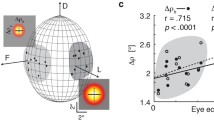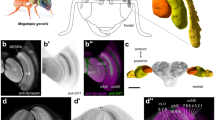Summary
-
1.
The optomotor behaviour of stationary flying bees in a two-colour rotating drum was investigated. The drum was illuminated with spectral lights within the range 343 mn–615 nm (Fig. 1.)
-
2.
Bees do not react to colours of the same animal-subjective brightness (Figs. 6, 7 and 8). The colour vision system is thus distinct from the optomotor system.
-
3.
A very accurate spectral sensitivity curve was obtained. This curve is very similar to the sensitivity curve of the bee's green receptor (Fig. 9). Thus the green receptors provide the dominant input to the optomotor system of the bee.
-
4.
The contribution of the UV and/or blue receptors is discussed. The results obtained from investigations of the direction-specific, movement-sensitive neurons of the bee are also considered.
-
5.
The significance of the fact that the reaction curves pass through zero for published models of the circuitry of the optomotor system is discussed.
-
6.
The principle of the separation of the colour vision system from the motion detection system is assumed to be generally applicable to insects.
Zusammenfassung
-
1.
Das optomotorische Verhalten von fixiert fliegenden Honigbienen in einer 2farbigen Drehtrommel wurde untersucht. Die Drehtrommel wurde mit Spektrallichtern (343–615 nm) beleuchtet (Abb. 1).
-
2.
Auf Farben gleicher bienensubjektiver Helligkeit reagieren die Bienen nicht (Abb. 6–8). Parbsehsystem und optomotorisches System sind demnach zwei getrennte Systeme.
-
3.
Eine sehr genaue spektrale Empfindlichkeitskurve wurde gewonnen. Sie ist der Empfindlichkeitskurve des Grünrezeptors der Biene sehr ähnlich (Abb. 9). Die Grünrezeptoren liefern also den dominanten Beitrag zum optomotorischen System der Biene.
-
4.
Der Beitrag der UV- und/oder Blaurezeptoren wird diskutiert. Dabei werden auch Untersuchungen über richtungsspezifisch bewegungssensible Neuronen der Biene berücksichtigt.
-
5.
Die Konsequenz der Nulldurchgänge der Reaktions-Kurven für in der Literatur beschriebene Modelle zur Versehaltung des optomotorischen Systems wird diskutiert.
-
6.
Vermutlich gilt das Prinzip der Trennung des Farbsehsystems vom Bewegungssehsytem bei Insekten allgemein.
Similar content being viewed by others
Literatur
Autrum, H., Zwehl, V. v.: Die spektrale Empfindlichkeit einzelner Sehzellen des Bienenauges. Z. vergl. Physiol.48, 357–384 (1964)
Bishop, L. G.: The spectral sensitivity of motion detector units recorded in the optic lobe of the honeybee. Z. vergl. Physiol.70, 374–381 (1970)
Bishop, L. G., Chung, D. W.: Convergence of visual sensory capabilities in a pair of Batesian mimics. J. Insect Physiol.18, 1501–1508 (1972)
Collett, T.: Visual neurones in the anterior optic tract of the privet hawk moth. J. comp. Physiol.78, 396–433 (1972)
Daumer, K.: Reizmetrische Untersuchungen des Farbensehens der Bienen. Z. vergl. Physiol.38, 413–478 (1956)
Eckert, H.: Die spektrale Empfindlichkeit des Komplexauges vonMusca. (Bestimmung aus Messungen der optomotorischen Reaktion.) Kybernetik9, 145–156 (1971)
Goldsmith, T. H.: The nature of the retinal action potential, and the spectral sensitivities of ultraviolet and green receptor systems of the compound eye of the worker honeybee. J. gen. Physiol.43, 775–799 (1960)
Helversen, O. v.: Zur spektralen Unterschiedsempfindlichkeit der Honigbiene. J. comp. Physiol.80, 439–472 (1972)
Horridge, G. A.: Perception of polarization plane, colour and movement in two dimensions by the crabCarcinus. Z. vergl. Physiol.55, 207–224 (1967)
Kaiser, W.: Zur Frage des Unterscheidungsvermögens für Spektralfarben: Eine Untersuchung der Optomotorik der königlichen GlanzfliegePhormia regina Meig. Z. vergl. Physiol.61, 71–102 (1968)
Kaiser, W.: Optomotor response studies with spectral lights—behavioural evaluation and single unit recordings in honeybees. In: Abstracts 14. International Congress of Entomology, Canberra, 22–30. August 1972, p. 151 (1972a)
Kaiser, W.: A preliminary report on the analysis of the optomotor system of the honeybee—single unit recordings during stimulation with spectral lights. In: Information processing in the visual systems of arthropods (ed. R. Wehner), pp. 166–170. Berlin-Heidelberg-New York: Springer 1972b
Kaiser, W., Bishop, L. G.: Directionally selective motion detecting units in the optic lobe of the honeybee. Z. vergl. Physiol.67, 403–413 (1970)
Kaiser, W., Liske, E.: A preliminary report on the analysis of the optomotor system of the bee—behavioural studies with spectral lights. In: Information processing in the visual systems of arthropods (ed. R. Wehner), pp. 163–165. Berlin-Heidelberg-New York: Springer 1972
Kirschfeld, K.: Optomotorische Reaktionen der Biene auf bewegte „Polarisations-Muster”. Z. Naturforsch.28 c, 329–338 (1973)
Kunze, P.: Untersuchung des Bewegungssehens fixiert fliegender Bienen. Z. vergl. Physiol.44, 656–684 (1961)
Labhart, T.: The discrimination of light intensities in the honey bee. In: Information processing in the visual systems of arthropods (ed. R. Wehner), pp. 115–119. Berlin-Heidelberg-New York: Springer 1972
Magnus, D.: Experimentelle Untersuchungen zur Bionomie und Ethologie des KaisermantelsArgynnis paphia L. (Lep. Nymph.). I. Über optische Auslöser von Anfliegereaktionen und ihre Bedeutung für das Sichfinden der Geschlechter. Z. Tierpsychol.15, 397–426 (1958)
Menzel, R.: Spectral response of moving detecting and “sustaining” fibres in the optic lobe of the bee. J. comp. Physiol.82, 135–150 (1973)
Palka, J.: Moving movement detectors. Amer. Zoologist12, 497–505 (1972)
Sachs, L.: Statistische Auswertungsmethoden, 3. Auflage. Berlin-Heidelberg-New York: Springer 1972
Schlieper, C.: Der Farbensinn vonHippolyte, zugleich ein Beitrag zum Bewegungssehen der Krebse. Verh. dtsch. Zool. Ges., Kiel 1926, S. 188–193 (1926)
Schlieper, C.: Farbensinn der Tiere und optomotorische Reaktionen. Z. vergl. Physiol.6, 453–472 (1927)
Schlieper, C.: Über die Helligkeitsverteilung im Spektrum bei verschiedenen. Insekten. Z. vergl. Physiol.8, 281–288 (1928)
Seibt, U.: Der Einfluß der Temperatur auf die Dunkeladaptation vonApis mdlifica. Z. vergl. Physiol.57, 77–102 (1967)
Thomas, I., Autrum, H.: Die Empfindlichkeit der dunkel- und hell-adaptierten Biene (Apis mellifica) für spektrale Farben: Zum Purkinje-Phänomen der Insekten. Z. vergl. Physiol.51, 204–218 (1965)
Tinbergen, N., Meeuse, B. J. D., Boerema, L. K., Varossieau, W. W.: Die Balz des Samtfalters,Eumenis (=Satyrus) semele (L.) Z. Tierpsychol.5, 182–226 (1942)
Wasserman, G. S.: Invertebrate color vision and the tuned-receptor paradigm. Science180, 268–275 (1973)
Author information
Authors and Affiliations
Additional information
Herrn Prof. Dr. Carl Schlieper zum 70. Geburtstag gewidmet.
Wir danken der Deutschen Forschungsgemeinschaft für die unter Ka 276/1 und unter Az. 741,29 gewährte Unterstützung. Den Herren Prof. Dr. Dr. h. c. H. Autrum und Prof. Dr. D. Burkhardt sowie dem Fachbereich Biologie der Universität Frankfurt gilt unser Dank für die leihweise Überlassung von Geräten. Herrn Feinmechanikermeister H. Niemetz danken wir für den Bau des Drehmomentmeß-instrumentes.
Rights and permissions
About this article
Cite this article
Kaiser, W., Liske, E. Die optomotorischen Reaktionen von fixiert fliegenden Bienen bei Reizung mit Spektrallichtern. J. Comp. Physiol. 89, 391–408 (1974). https://doi.org/10.1007/BF00695355
Received:
Issue Date:
DOI: https://doi.org/10.1007/BF00695355




